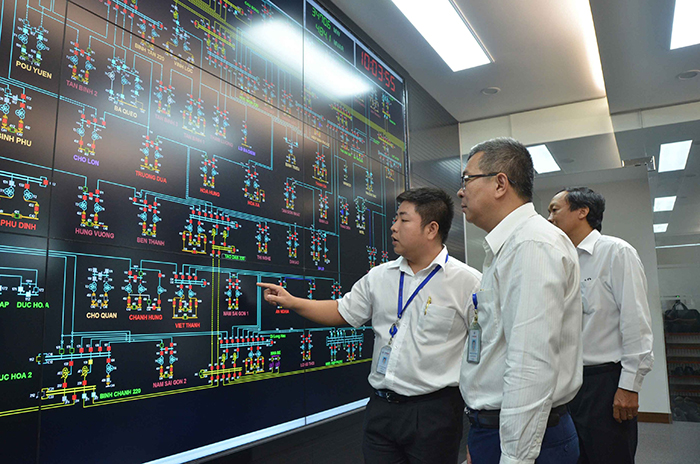
Mr. Le Viet Hung, Deputy Director of EVN’s Technical – Operation Department
Reporter: Could you tell us, what breakthrough solutions has EVN taken to reduce power loss rate over the last time?
Mr. Le Viet Hung: Solutions to reduce power loss in Vietnam are similar to those applied in other countries in the world, including solutions of operation management, business management, investment in power grid upgrading, etc.
EVN’s member organizations have implemented solutions suitable and effective for each area and promoted the awareness and accountability of every employee in this work.
As a result, EVN's power loss rate was 7.04% in 2018 and 6.5% in 2019.
Reporter: EVN has reached the finish line a year ahead in implementing the power loss reduction. Could you please tell us the next target in performing this task?
Mr. Le Viet Hung: In 2019, the Group has completed the 2016-2020 planned target, the power loss rate reduced to 6.5%, (1 year ahead of the plan). Up to now, the Group's power loss rate has decreased to a low level. Therefore if a further reduction of power loss is expected, it is necessary to invest in upgrading the power grid, which requires due consideration of investment efficiency and possibility of return on investment. We are performing investments in power system development in accordance with the Government - approved master plan. However, during execution of the master plan, many power projects have been behind schedule due to lack of capital, delay in land acquisition, delayed construction progress caused by contractors’ faults. The development of power grid has not kept up with the growth of load, leading to the full-load and overload of power lines, substations, etc., which would cause an increase in power loss rate of member organizations. In particularly, if the loss rate of transmission grid cannot be diminished to 2.15%, it will be a big difficulty in the realization of the overall power loss reduction target.

Ho Chi Minh City Power Corporation has applied many scientific and technological achievements in managing and operating the power grid, thus reducing the power loss rate.
Reporter: Sir, besides the general efforts of the whole Group, in some member organizations, the power loss rate is still higher than planned. Which mechanism of rewards and penalties have been introduced by EVN related to the power loss rate?
Mr. Le Viet Hung:
The reward and penalty mechanism of the Group is very clear, associated with responsibilities of every organization or individual. If an organization does not meet the planned targets due to subjective causes, the salary of its employee will be affected. In addition, if due to reckless management, power loss rate rises by subjective errors, the head of the organization will be considered as not accomplishing his/her assignments, and if the situation lasts for two consecutive years, he/she will be dismissed.
Reporter: There is an opinion that the power loss rate will increase again in a certain period due to the continued transmission of high power output to the South and the delay in implementation progress of many power generation and power grid projects. What is your comment on this opinion?
Mr. Le Viet Hung: Currently EVN's power loss rate is very low, close to the technical threshold. Any changes of load, generation mix or progress of projects will affect the power loss rate.
In some power companies, when the industrial production value decreases, the power loss rate will increase, however the range of increase will fluctuate around the technical threshold rather than as high as before. Once the power loss is in a low level, it may increase slightly in the short term if the grid investment plan is slower than the load growth. This fact has happened in many countries with low power loss rates, reaching technical thresholds.
In the coming time, if adverse factors such as delayed progress of power generation and grid projects, or transmission of high power output to the South are not resolved, power loss rate will probably rise, but not by over 1%.

EVNNPT is cleaning porcelain insulators using live-line working technology, helping reduce the power loss rate
Reporter: Some countries and territories have very low power loss rates (about 3%) such as Singapore, Israel, Taiwan, etc., has Vietnam set this target, sir?
Mr. Le Viet Hung: Power loss depends on characteristics of power system of each country, so comparisons between countries are just relative.
Countries and territories such as Singapore, Israel, and Taiwan have small areas, concentrated loads, strong and modern power systems with high reliability, not very long power lines, these natural advantages help them achieve their low power loss rates. In Vietnam, there are provinces with concentrated loads, where power loss rates are low, for example such as Binh Duong (2.95%), Lao Cai (2.97%), Da Nang (3.0%), Dong Nai (3, 35%), etc.
Nevertheless, in many provinces in Vietnam, the power grids are extended, operation conditions are difficult, power loss rates in these provinces therefore are higher than 7%, such as Tuyen Quang, Ninh Binh and Thanh Hoa. The reduction of power loss rate down to 3% is possible, but requires a great deal of capital. Efficiency of power loss reduction in these provinces will be very low compared to the investment capital requirement. Therefore, the investment in power loss reduction needs to be studied and considered carefully, otherwise it will cause great waste.
Even some developed countries do not set the goal of reducing power loss rate at all costs. According to our data, many countries have higher loss rates than Vietnam, such as Russia (10%), United Kingdom (8.3%), India (18%), Brazil (15). %), Hong Kong (12%), Hungary (12%), Romania (10%), Ukraine (10%), Spain 9.5%, etc.
The power loss rate of Vietnam is currently relatively good. The reduction of power loss rate should be associated with the efficient use of investment capital. It is not essential to focus too much resources on reducing power loss rate.
Reporter: Thank you!
evn.com.vn
Share